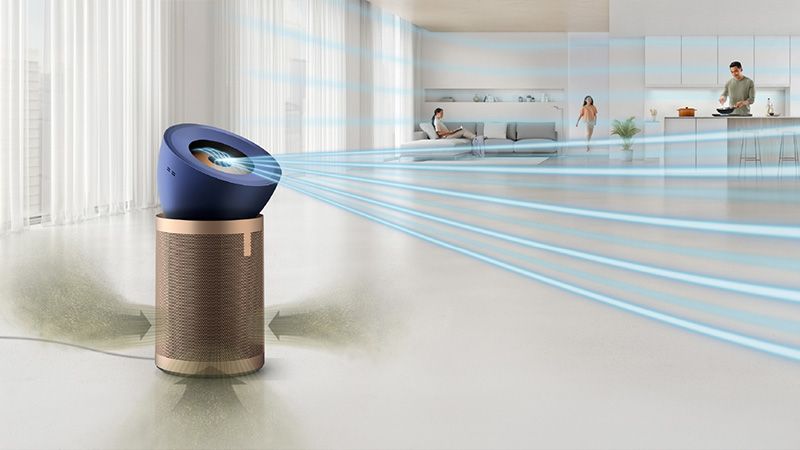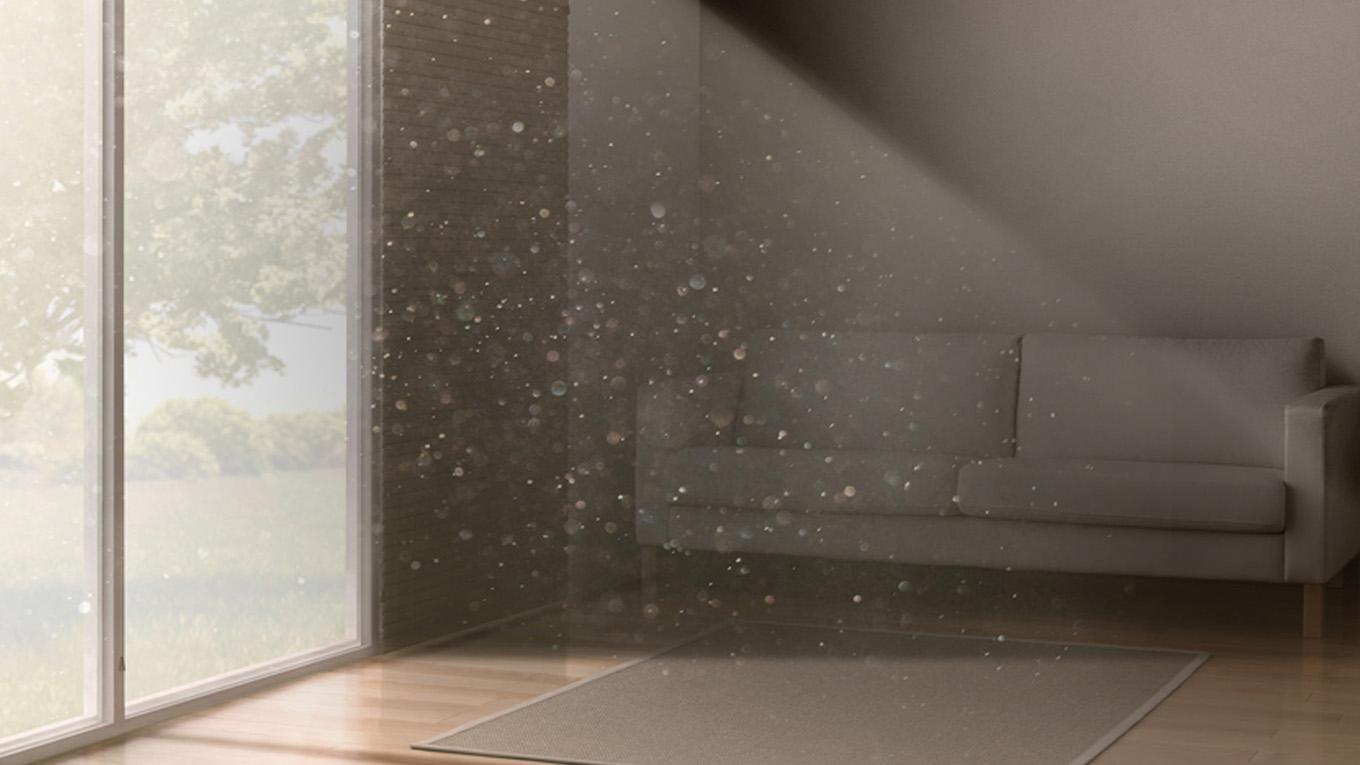-
-

-
How to choose the best air purifier
Air purifiers help improve indoor air quality and give you peace of mind that you’re breathing cleaner air at home.
We spend up to 90% of our time indoors,¹ and the air in our homes can be polluted with allergens, dust, and other particles. In fact, studies from the Environmental Protection Agency (EPA) indicate that the levels of indoor air pollutants can be up to five times higher than outdoor levels.
So the quality of indoor air not only affects your comfort level, but your health as well.
-
How does an air purifier work?
Many air purifiers are portable machines that sense, capture, and trap unwanted airborne particles from a room. Cleaned and purified air is then projected back into the room. To improve indoor air quality, this filtration process occurs continuously while the air purifier is in use.
Common sources of air pollution
Indoor air pollution comes from several sources around your home. Cleaning products and candles can emit benzene and volatile organic compounds (VOCs), while carpets, rugs, and flooring can emit formaldehyde. Gas stoves release nitrogen dioxide while in use, and household fumes, cooking, and smoking release odors into the air.
If you have pets, they can release common allergens like dander and bring in pollen from the outside. Dust, dust mites, bacteria, and mold spores are other common allergy triggers that can be found in indoor air.
Air purifiers work to trap and contain these common sources of air pollution. Because they’re portable, air purifiers can be moved to different rooms during the day and night, or you can set up multiple air purifiers throughout your home.
What to look for in an air purifier for your home?
According to the EPA, your air purifier should be able to process the air in your room five times per hour. We also recommend paying attention to the manufacturer’s recommended room size for each purifier, as this will help you find a machine that’s ideal for your space.
Another guideline for choosing an air purifier is the Clean Air Delivery Rate (CADR). These ratings provide you with information on how quickly the air purifier removes pollutants like dust, smoke, and pollen from one cubic foot of air in one minute. Air purifiers with higher ratings can purify the air in larger spaces more frequently per hour.
Air purifiers are made with different types of filters. High-efficiency particulate air (HEPA) filters remove allergens like dust, dander, and pollen from the air inside. HEPA air purifiers remove 99.95% of particles as small as 0.1 microns. Charcoal and active carbon filters help to remove odors from the air by trapping and sealing in smoke, cooking gases, and VOCs. Air purifiers with both HEPA filtration and active carbon or charcoal filtration remove both pollutants and odors from indoor air.
Choosing the best air purifier for your needs
When it comes to choosing the best air purifier for your needs and your home, there are some considerations to keep in mind that will help you decide.
Allergies
One reason to buy a purifier is to help capture allergens. Many common allergens are airborne, and an air purifier removes those particles to provide cleaner air indoors. It’s helpful to research the type of allergens a purifier can capture. Opting for an air purifier with a HEPA filter will ensure that common allergens are trapped, and you’ll have peace of mind that you’re breathing cleaner air.
Room size
It’s important to consider room size when choosing an air purifier for your home. You’ll need to determine whether you need a small or large air purifier. If the machine will be placed in a bedroom or office, a small or medium-sized machine will work. If you’ll be using your air purifier in a large living room or open plan living area, you’ll need a machine that can project purified air throughout the whole space.
Frequency of use
For the best results, your air purifier should run continuously. If you plan to run your purifier regularly, consider the noise level at the highest and lowest speeds. A volume of less than 30 decibels will allow you to sleep peacefully. If you plan to have an air purifier in your bedroom, consider one that offers a night mode.
Additional heating, cooling, or humidifying
Some air purifiers serve just one purpose: to purify indoor air. Other machines offer additional benefits such as cooling, humidifying, and heating. When choosing the best air purifier for your needs, determine if you simply want the air cleaned, or if you’d like to cool, heat, or humidify the room as well.
Smoke
Another consideration to keep in mind when shopping for an air purifier is whether there are smokers in your home. Like with allergies, certain purifiers can remove smoke from the air. An air purifier with a charcoal or active carbon filter can help to remove the smell of smoke from the room and provide cleaner air.
Wildfires
Wildfires affect outdoor air quality as wildfire smoke is made of gases, fine particles, and pollutants like VOCs, nitrogen dioxide, and benzene. Indoor air quality can also be impacted if smoke comes inside through open doors and windows. If you live in an area with wildfire seasons, opt for a HEPA air purifier that traps and seals in gases and fine particle pollution, and filters purified air into the room.
App connectivity
Some air purifiers connect to an app from the manufacturer. These apps allow you to control your machine from your smart device. They also provide updates and reports on air quality and alert you when your machine needs maintenance or a filter replacement.
Now that you’ve thought through the different considerations, you’re ready to shop for the best air purifier to meet your needs and help clean your air at home.
Explore the Dyson air treatment range
-
Purifiers
Circulates purified air around the whole room. Captures gases², allergens and 99.97% of particles as small as 0.3 microns.
-
Purifier humidifiers
Automatically humidifies and purifies. Engineered to deal with pollution and dry air.
-
Fans and heaters
Control your temperature with fast heating and high-velocity cooling.
Read more
-
Insights | Air quality | Air purifier
-
Insights | Air quality | Air purifier
-
Insights | Air quality | Air purifier
Discover Dyson
Sources
¹Klepeis et al 2001; Schweizer et al 2007
https://www.epa.gov/iaq-schools/why-indoor-air-quality-important-schools#:~:text=EPA%20studies%20of%20human%20exposure,times%20%E2%80%94%20higher%20than%20outdoor%20levels.&text=These%20levels%20of%20indoor%20air,percent%20of%20their%20time%20indoors
https://www.epa.gov/indoor-air-quality-iaq/air-cleaners-and-air-filters-home
https://www.epa.gov/indoor-air-quality-iaq/improving-indoor-air-quality
https://www.cpsc.gov/Safety-Education/Safety-Guides/Home/The-Inside-Story-A-Guide-to-Indoor-Air-Quality
https://www.epa.gov/sites/default/files/2018-07/documents/guide_to_air_cleaners_in_the_home_2nd_edition.pdf
https://www.consumerreports.org/appliances/air-purifiers/buying-guide/
https://www.cnn.com/cnn-underscored/home/how-to-choose-air-purifier
https://www.self.com/story/air-purifier-buying-guide
https://www.tomsguide.com/reference/air-purifier-buying-guide
https://www.bestbuy.com/site/buying-guides/air-purification/pcmcat326200050000.c
https://www.missionallergy.com/faqs-choose-air-cleaner
https://www.dyson.com/knowledge/air-quality/indoor-air-quality-causes-treatments-and-prevention
https://www.dyson.com/knowledge/air-quality/indoor-air-quality-common-sources-of-indoor-air-pollution
https://www.dyson.com/knowledge/air-quality/how-to-improve-indoor-air-quality
https://www.dyson.com/knowledge/air-quality/5-ways-to-improve-indoor-air-quality
https://www.dyson.com/knowledge/air-quality/6-ways-to-reduce-exposure-to-wildfire-smoke?source_description=yext%7Ehelp_articles%7E51662871
https://www.dyson.com/newsroom/features/technology/what-is-a-hepa-filter-and-its-benefits?source_description=yext%7Ehelp_articles%7E52044715
Press contacts
Canada
Email us at CAN.PR@dyson.com
Social media
Twitter: @askdyson
YouTube: youtube.com/Dyson
Facebook: facebook.com/dyson
Instagram: @dyson, @dysonbeauty
LinkedIn: Dyson







